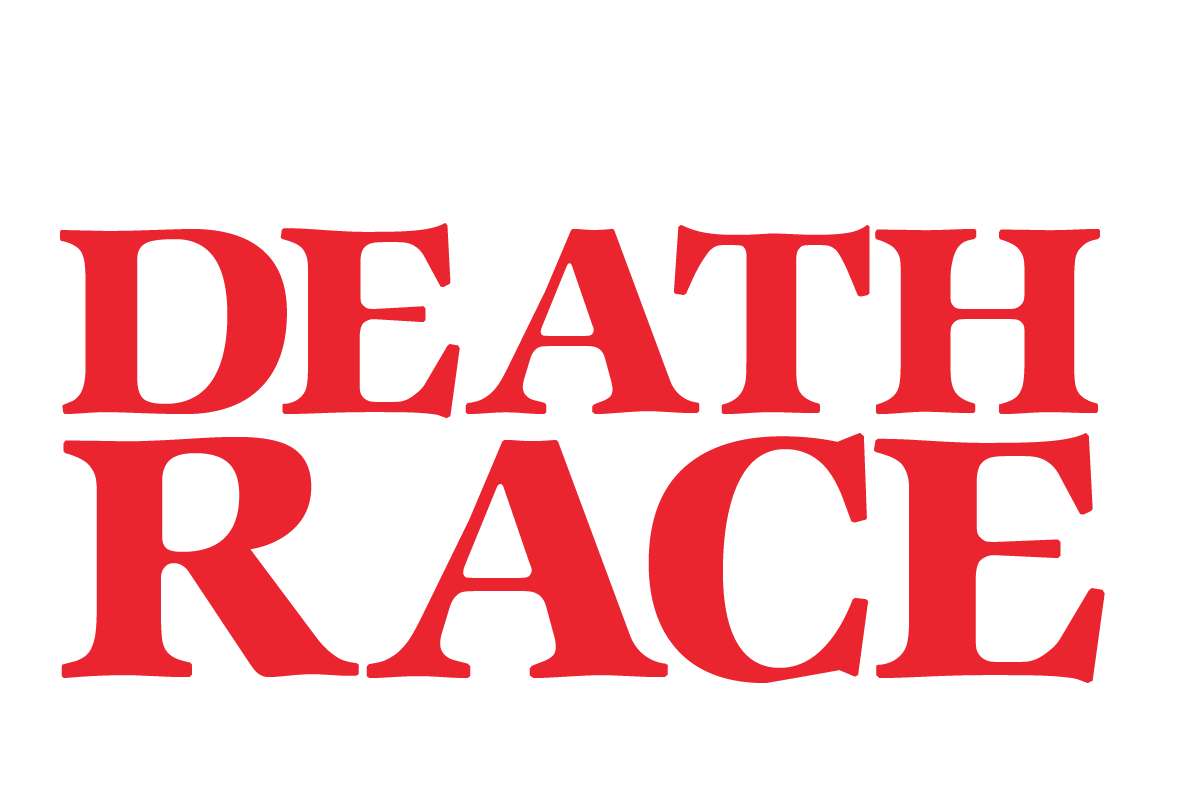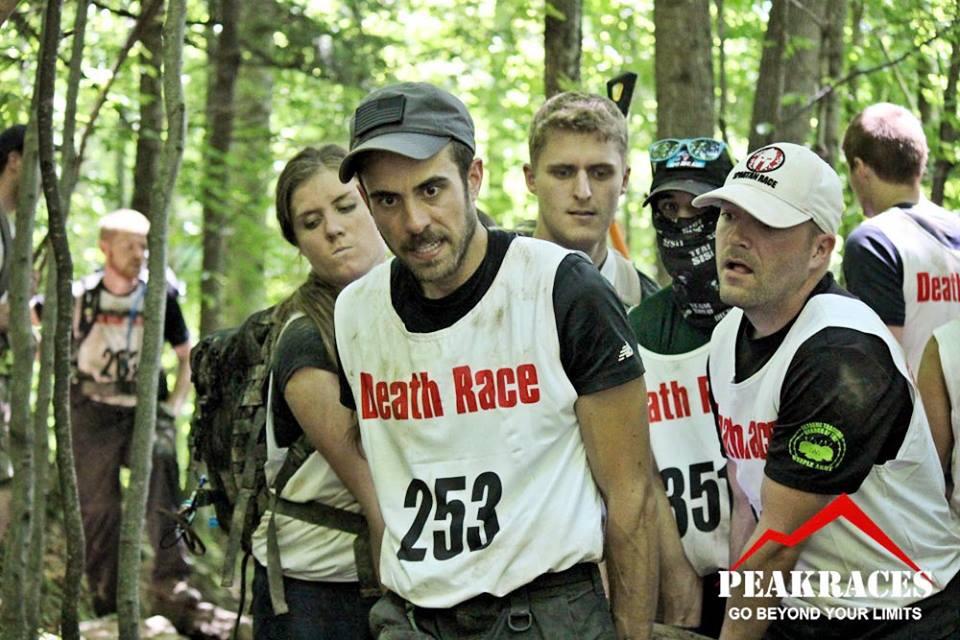In the middle of the Death Race, I was pulled from the action to give a quick interview for the new Spartan podcast that they were recording. They asked me simple questions with complex answers, “Why was I out there? Why return to the Death Race?” Those answers are not the easiest to answer on the spot. I was out there racing for a multitude of reasons. Firstly, I was out for redemption from the previous year. Next, I had a burning desire to at last earn the coveted “official” finish. I wanted to gain an understanding that with each Death Race I learn something new about myself. I cannot remember exactly what I said on that podcast, but I’m thankful it was early on in the race, because who knows want kind of ramble and fumble on my words I might have had were it 36, 48 or even 60 hours into the race?
After finishing the short interview, Chris urged me with, “Hurry up, Mr. Celebrity,”or something to that effect. I jumped right back in with Chris and Brian and we worked our way up the mountainside staircase. We lugged and struggled to move what would become new stone stairs to their new home on the mountain. The year before when these stairs were built there were sections where racers took the utmost care in making sure the boulders were properly set; with other sections, not so much. There were a few sections where very large, nearly immovable boulders were careful placed and others where smaller stones, able to be carried by a single person, were simply placed with little effort in securing and setting them into the earth. The key to building a solid stone staircase along a mountain is making the stairs appear to be one with the earth. The objective was for it to appear as though these stone had been there for thousands of years. This year, we were rebuilding the sections that fell apart from careless placement. Because of the lack of effort in properly placing these sections, the weather and snow, and their overuse caused the stones to become a danger to those who used them on a regular basis.
Unlike the prior year, this task would not and should not have taken the same 24 hours to complete because only a few sections near the mid-mountain and upwards towards the top that were in need of repair. Some people look at these tasks as simply doing Joe’s landscaping. What many fail to understand is we are doing so much more than that. We’re working together as a team to build something that will forever be a part of this mountain. These stairs will be here for generations. A man-made structure so great that we all can own our accomplishment and one day return to say, “Along with my comrades, I built this.”That’s something so unbelievably awesome, it brings joyous tears to my eyes every time I think about what a group of 200 fellow Death Racers and I are able to achieve.
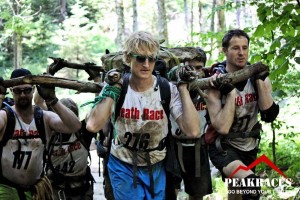 It was a lot of working lugging these enormous stones up and down the mountain, but with teamwork and camaraderie anything is possible, even when it doesn’t seem that way. All around me, I could see Death Racers working together, making the impossible, possible. The ingenuity of the racers is something to admire. Some racers utilized rope and webbing and such to fashion together different dragging systems. Others found sizable tree limbs and created a basket of sorts from their buckskin to carry the boulders in. After Chris, Brian and I brought our rocks up to their place we were sent back to the top of Tweed River Drive to ensure that all the stones had made their way back.
It was a lot of working lugging these enormous stones up and down the mountain, but with teamwork and camaraderie anything is possible, even when it doesn’t seem that way. All around me, I could see Death Racers working together, making the impossible, possible. The ingenuity of the racers is something to admire. Some racers utilized rope and webbing and such to fashion together different dragging systems. Others found sizable tree limbs and created a basket of sorts from their buckskin to carry the boulders in. After Chris, Brian and I brought our rocks up to their place we were sent back to the top of Tweed River Drive to ensure that all the stones had made their way back.
On our way back down the trail we saw a collection of abandoned stones by those who gave up on moving the oversized monstrosities. As we passed one we had the unfortunate luck of being in the vicinity of the man known as the Task Master, Don Devaney. As usual he was in his angry, yelling Death Race character, which I now find to be more humorous than anything else. My inability to take him seriously anymore tends to get me in to some less than desirable situations. That held true here. Don saw us and immediately directed us to pick up the nearest stone. It was an obnoxiously large one. One that quite frankly looked a bit phallic. As soon as Don carried on we did attempt to move the stone only to quickly discover why it had been abandoned. Though in size it shouldn’t have been too much for the three of us, it was. The density of this stone was surprising. Once Don was completely out of sight we ditched the rock in the woods, in truth it wouldn’t have made a very good step, I mean it looked like a penis for crying out loud. It was clear to us why this stone was abandoned, and I’m not talking about its shape, if three strong men had difficulty moving it, how much effort was it worth? There were still plenty of other abandoned stones along the path that we could move and so we found another and carried on.
We found a couple who was working on moving a stone though they were not moving very far. Instead of grabbing our own stone we jumped in with them and decided to lend a much needed hand. Together, we worked to move the stone they appeared to be struggling on for some time. It was awkwardly shaped forcing us to carry it in most particular way. Some edges were round making the ability to have a good grip difficult. We heaved and hoed, taking breaks every 20-30 steps as needed. The breaks were short, mostly to readjust grip and give the forearms a bit of relief.
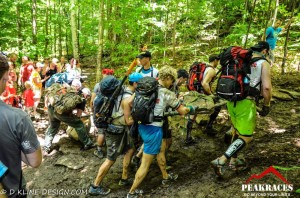 Arriving back at the staircase, we brought the stone we carried to the nearest spot it was needed. All the while we had dropped our bags in what we had hoped to be a safe location. Once the stone was dropped for other racers to secure, we quickly made our way back to the tree that Brian, Chris and I had dropped our bags. Having exerted a significant amount of energy over the past couple hours, we made sure to hydrate and fuel ourselves a bit before moving our bags up the mountainside. From there, the three of us continued to find others who needed assistance in transferring the substantially large boulders up the mountain. Our preferred method of moving them was via a rope system. It [the rope] would be secured to the stone, then six or more handles were attached to distribute the weight. From there it was simply a system of pulling as far as we could then repositioning ourselves and doing it all again. As often as possible we would utilize the leverage we could generate from wrapping some of the rope around the nearby trees. This helped speed up the process and we would just zig-zag bouncing from one tree to the next for added leverage. Science, gotta love it.
Arriving back at the staircase, we brought the stone we carried to the nearest spot it was needed. All the while we had dropped our bags in what we had hoped to be a safe location. Once the stone was dropped for other racers to secure, we quickly made our way back to the tree that Brian, Chris and I had dropped our bags. Having exerted a significant amount of energy over the past couple hours, we made sure to hydrate and fuel ourselves a bit before moving our bags up the mountainside. From there, the three of us continued to find others who needed assistance in transferring the substantially large boulders up the mountain. Our preferred method of moving them was via a rope system. It [the rope] would be secured to the stone, then six or more handles were attached to distribute the weight. From there it was simply a system of pulling as far as we could then repositioning ourselves and doing it all again. As often as possible we would utilize the leverage we could generate from wrapping some of the rope around the nearby trees. This helped speed up the process and we would just zig-zag bouncing from one tree to the next for added leverage. Science, gotta love it.
As we move the stones up and set them in place one by one, you could see this incredible amount of team work happening all around you. It reminded me of the Hurricane Heat I had been leading for Spartan Race. A bunch of strangers and friends coming together to do incredible feats. What makes the Death Race so much more incredible is the notion that we’re actually building something that will be here for centuries; I cannot help but come back to this thought over and over. As the final rocks were being set in place in one section we were sent further up to help. When Chris, Brian and myself arrived at the highest point of the staircase build we were informed there was no need to go any further. It was clear there was no need for more bodies up here, as the path was narrow and already a cluster of Death Racers working tirelessly to secure the final few stones into place. The volunteer didn’t know what to tell us other than to look busy, so we started moving any spare stones out of the way and headed back.
Shortly after chucking a few stones off the beaten path and into the brush, the racers were informed the task had come to an end and we were rounded up by Johnny Waite. He made an announcement that the following names he would be calling off had done an exceptional job thus far in the race. This earned the opportunity to get a small head-start to the next challenge. There was an opportunity for the racers to nominate a few additional people that may have been missed by the race directors. After that those few lucky individuals earned a good three to five minute lead on the rest of us.
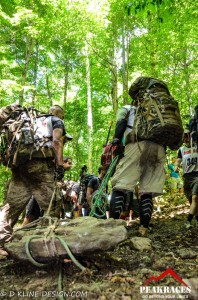 Our mission, was to run back down the mountain to Riverside Farm. To my advantage I knew this mountain very well from all my visits over the course of three years and I was able to take a few shortcuts that easily took minutes off my time getting back down. With a full ruck, I was running as fast as my legs allowed me to run. As I approached Riverside Farm I saw that there were some water bottles lined up as well as other items. It turned out my suspicions were correct, the volunteers and race directors did snag some of our items from our rucks when they had piled them all on top of each other. The blue Nalgene water bottle I borrowed from Mark Webb, included. As we ran up they explained that you must complete fifty burpees to retrieve your item, unless it was a water bottle in which case you could simply pick it up. I ran up without hesitation scooped up the water bottle and headed towards the area where we picked up our bibs earlier that morning.
Our mission, was to run back down the mountain to Riverside Farm. To my advantage I knew this mountain very well from all my visits over the course of three years and I was able to take a few shortcuts that easily took minutes off my time getting back down. With a full ruck, I was running as fast as my legs allowed me to run. As I approached Riverside Farm I saw that there were some water bottles lined up as well as other items. It turned out my suspicions were correct, the volunteers and race directors did snag some of our items from our rucks when they had piled them all on top of each other. The blue Nalgene water bottle I borrowed from Mark Webb, included. As we ran up they explained that you must complete fifty burpees to retrieve your item, unless it was a water bottle in which case you could simply pick it up. I ran up without hesitation scooped up the water bottle and headed towards the area where we picked up our bibs earlier that morning.
All along the tree line there were small log stumps all in a line, enough for over 200 participants. Some had X’s spray painted in black on them, others had O’s and a few even had what appeared to be a capital letter E painted into the grain. Our objective was simple enough, grab the log and head over to Bloodroot Mountain Trail. Bloodroot has become one of the constants of the Death Race. You know you’ll face this mighty mountainous trail at one point or another during the Death Race. The only question is when. In my first year it was one of the very first tasks, in my second is came later in the game and involved a night hike, this time it was early enough to ascend in the daylight but how far we were going and what lay ahead remained a mystery. With my log in my hands I began hustling my way across Route 100 up the drive way that led to my co-worker, Jason Jaksetic’s house which led to the road to Bloodroot.
To be continued…
Photography Credit: Marion Abrams and Doug Kline
